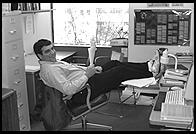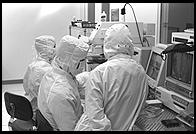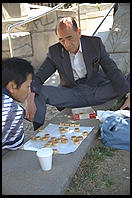
Canon Rebel G (EOS 500N)
by Philip Greenspun; created 1995
Site Home : Photography : Canon Rebel G (EOS 500N)

by Philip Greenspun; created 1995
Site Home : Photography : Canon Rebel G (EOS 500N)
This article is for two types of readers:
 The Rebel G is incredibly
lightweight, about half the weight of an Elan II or an EOS-5.
The Rebel G is incredibly
lightweight, about half the weight of an Elan II or an EOS-5.
The viewfinder seems cramped and it is tricky to position your eye so that you can see everything, especially for this big-nosed eyeglass wearer [note that Canon makes an EP-EX15 eyepiece extender to increase eye relief, but I haven't tried it]. There seem to be three AF sensors and they are widely separated. Unfortunately, the sensors don't light up red for focus confirmation like an EOS-5's. There is a round circle in the LCD screen at the bottom of the frame, like an old Nikon 8008.
The read-out shows aperture and shutter speed, which AF sensors are active, and a meter scale. Unlike the A2e, Canon did not cripple the USA model of the Rebel so you get a full meter scale in the viewfinder at all times, even in metered-manual mode.
Speaking of metered manual, you don't have a second control wheel on the back and you don't have an aperture ring on the lens. So the finger wheel changes the shutter speed and you have to cramp up your fingers to press a little shift button on the back while turning the same wheel to set the aperture. If you switch to an autoexposure mode, then the same little shift button and wheel dance will do exposure compensation. The amount of compensation is visible at all times in the viewfinder on the scale.
The camera basically is in multi-segment matrix metering magic mode by default. If you press the exposure lock button, it switches to meter the central 9.5% of the frame. It is conceivably possible to remember to use this feature in manual exposure mode, but I don't think that I will be able to remember it.
My theory is that this camera is useful only as a matrix-metered aperture-priority backup body for color neg film or TMAX 400 CN. Alternatively, it would be useful in the studio for flash exposures where one is setting the exposure on the camera manually. [By the way, if you want to use a Rebel G in the studio, remember that it has no PC cord socket. Moreover, I've had trouble getting my Canon bodies to trigger my Sinar Bron wireless trigger. Canon makes a little plastic box that sits in the hot shoe and has a PC cord output. Send a check for $32 plus your state sales tax to Canon USA, 1 Canon Plaza, Lake Success, NY 11042, attn: CPS. Ask for them to send you a "Hot Shoe to PC Adaptor". Questions? Call (516) 328-4840 and ask for Janet.]
Another glaring omission is the Rebel G's lack of a depth of field preview. With Nikon, one can understand why they leave this out on their cheap bodies, since they need a mechanical shove to stop the lens down. But in Canon's case, it would just have been an electric button somewhere.
The built-in flash is nice for fill. Unfortunately, you can't adjust its exposure. If you want a variable fill ratio, you'll need to use an accessory flash like the 540EZ that lets you set exposure compensation on the flash. As with all Canon bodies, the Rebel isn't designed to let you use the built-in flash pointing straight ahead in conjuction with a shoe-mounted accessory flash bounced up to the ceiling. It is a shame.
I guess this sounds pretty negative. It shouldn't. I paid $250 for my Rebel G. It makes a nice backup in a bag stuffed with $10,000 of EOS lenses and a real body such as the EOS-5. I think I'll use it for goofing around or to keep at the office.
I wish I could write more, but basically I think that this is a bad body for a beginner. It has all the confusion of a modern super AF body like the Elan II or EOS-5 without the capability. It is too hard to focus manually. It really ought to have depth of field preview. It is too hard to use in metered-manual mode (since you have only one control to set both aperture and shutter speed).
Though I've covered this ground in "what camera should I buy", I'll toss out a few things that I think are better than a Rebel G: Elan II, Nikon 6006, used Nikon 8008, Pentax K1000 or similar old manual body.
Oh yes, if you get one, you absolutely must get the cute GR-80TP grip. This is ridiculously cheap and expands into a tabletop tripod. Unlike the VG-10 grip for the EOS-5, it doesn't have an extra shutter release or control wheel, unfortunately.
 I had to go to San Francisco to meet
with a publisher (see
the book behind the book
story) and the Environmental Defense Fund
(some planning for
www.scorecard.org). I
started packing at 6 am for an 8 am flight. I knew that I'd only have a few spare
hours in which to take pictures. I didn't want to take a P&S camera because
I'm growing less fond of them. The camera that I could easily grab was
the Rebel G plus the 24-85 lens. I walked around the city for an
afternoon and exposed 85 pictures on Kodak Royal Gold 400, with the intention of
adding them to
this California exhibit. I mostly used
aperture priority autoexposure and left the camera to autofocus (and pick its AF
sensor) all of the time.
I had to go to San Francisco to meet
with a publisher (see
the book behind the book
story) and the Environmental Defense Fund
(some planning for
www.scorecard.org). I
started packing at 6 am for an 8 am flight. I knew that I'd only have a few spare
hours in which to take pictures. I didn't want to take a P&S camera because
I'm growing less fond of them. The camera that I could easily grab was
the Rebel G plus the 24-85 lens. I walked around the city for an
afternoon and exposed 85 pictures on Kodak Royal Gold 400, with the intention of
adding them to
this California exhibit. I mostly used
aperture priority autoexposure and left the camera to autofocus (and pick its AF
sensor) all of the time.
I sent the undeveloped film directly to Advanced Digital Imaging where they were scanned to a single Kodak PhotoCD (check it out if you want to see my yield). I converted them using the software that I describe in my book. Here are the best (IMHO) of the 85 images:
The bottom line? I found the combination practical for this photojournalism-type assignment.
Text and pictures (c) Copyright 1991-1995 Philip Greenspun